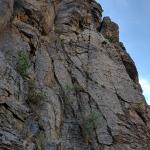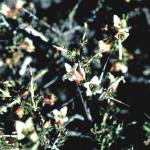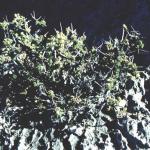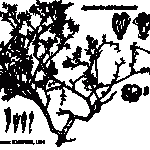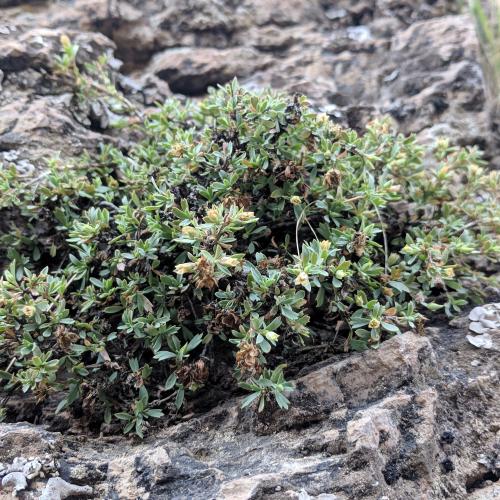Apacheria chiricahuensis (Cliff Brittlebush)
NONE
| USFWS | State of NM | USFS | BLM | Navajo Nation | State Rank | Global Rank | R-E-D Code | NMRPTC Status | Strategy Status |
|---|---|---|---|---|---|---|---|---|---|
| S2 | G2 | 2-1-2 | D | SS |
| Documented Threats |
|---|
No Information |
Shrub to 50 cm tall; leaves opposite, entire to 3-lobed, oblanceolate to spatulate, 3.5-7.5 mm long, 1.0-2.3 mm wide, apiculate, glabrous; stipules minute; flowers radially symmetric, borne singly, sessile or short pedunculate; sepals 4, 3.0-3.5 mm long; petals 4, white, cream-colored, or pink, 4-5 mm long; stamens 8; carpels 1-4; stigmas linear; fruits follicular with prominent striate veins; seeds 1-2, brown, averaging 1.5 mm long, 1 mm wide, with a white aril. Flowers April to August.
None
New Mexico, Hidalgo, Sierra, and Socorro counties; Arizona, Cochise County.
Mostly north-facing cliffs of limestone or rhyolite; 1,700-2,100 m (5,500-7,000 ft)
This species occurs on both limestone and rhyolite in the Black Range, San Mateo, San Andres, and Animas mountains in New Mexico, and the Chiricahua and Dragoon mountains in Arizona. It is reported to be fairly common in suitable habitat in the San Mateo Mountains and Richard Worthington reported that it can be locally abundant in suitable habitat in the Animas Mountains.
The cliffside habitats of this shrub offer considerable protection from human impacts, except for climate change.
*New Mexico Native Plants Protection Advisory Committee. 1984. A handbook of rare and endemic plants of New Mexico. University of New Mexico Press, Albuquerque.
*Mason, C.T., Jr. 1975. Apacheria chiricahuensis: a new genus and species from Arizona. Madroño 23(3):105-108. \ \
*Mason, C.T., Jr. 1992. Journal of the Arizona-Nevada Academy of Science 26(1):7-9.
For distribution maps and more information, visit Natural Heritage New Mexico

